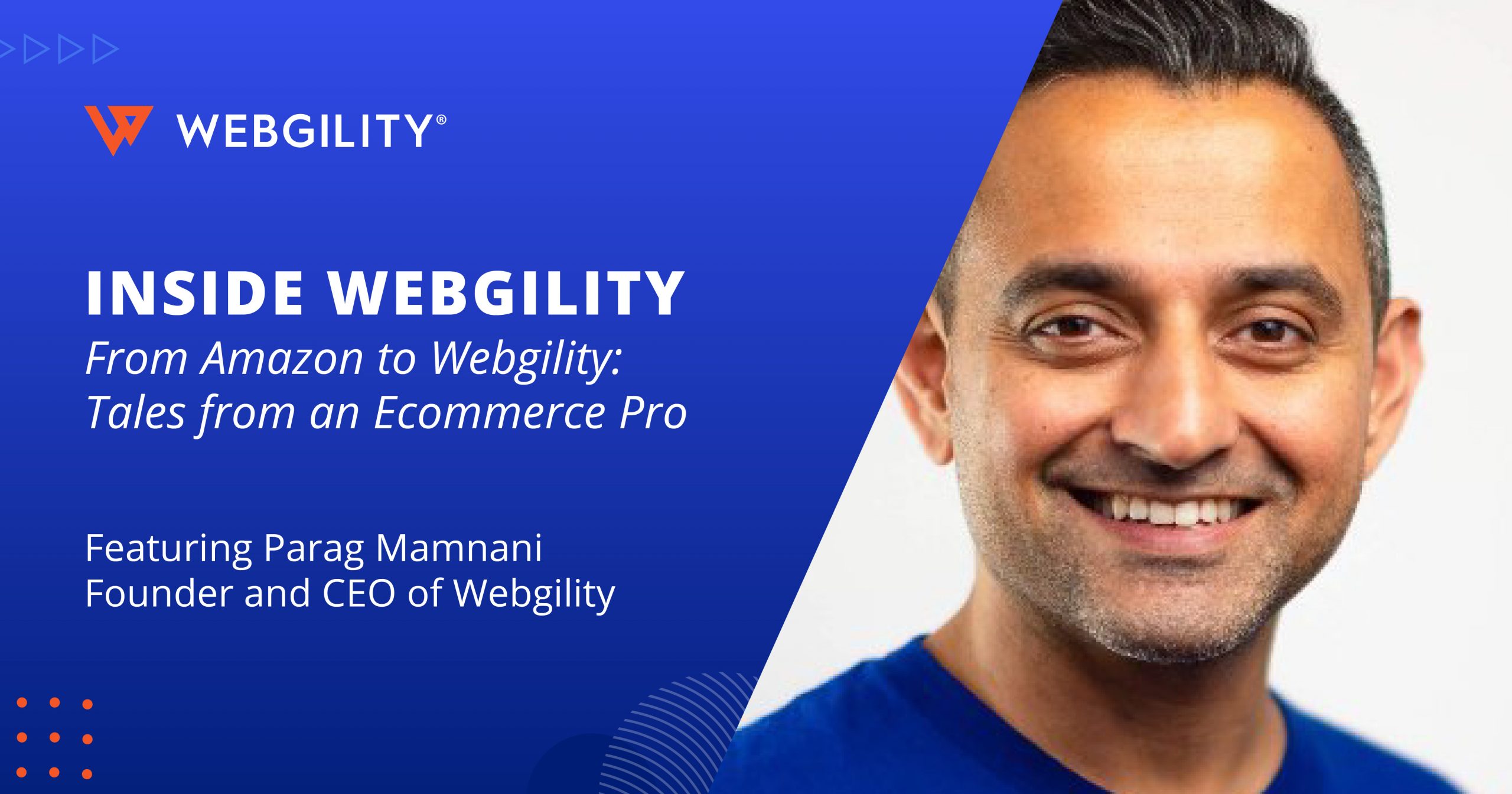
From Amazon to Webgility: Tales from an Ecommerce Pro
Contents
Parag Mamnani founded Webgility in 2007 to solve a critical pain point in ecommerce: accounting. Today, he’s focused on helping retailers run their businesses no matter where they sell.
Parag has two decades of experience in ecommerce. His first startup was a top-five web agency in Arizona that he started right out of college. He then went on to run the Amazon Webstore platform where he managed the product and helped onboard some of Amazon’s largest third-party sellers.
We caught up with Parag to hear the ins and outs of his inspiring ecommerce tech career and pick his brain about the future of retail.
Tell us about your time at Amazon. What was it like to work at such a powerhouse company?
Parag Mamnani: Working at Amazon is like getting a fast-track MBA. The company moves so rapidly, every day feels like it’s day one. You get the impression that you’re always just getting started. It’s incredible that they’re able to do so many things and still keep it all running smoothly.
It’s fascinating to me that the culture has been almost unchanged despite the explosive growth they’ve had over the last few decades. When I left Amazon, I was one of 25,000 employees. Now Amazon employs over 1 million people around the world, all members of that same driven environment.
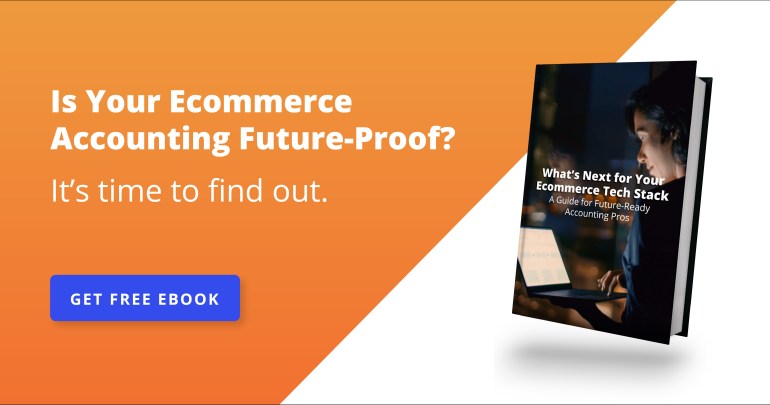
Since your time there, how has Amazon changed the game for ecommerce sellers?
Parag Mamnani: It’s impossible to overstate how influential Amazon is today. They’ve shown the ecommerce world a recipe for success: offer the best price, have the biggest selection, and deliver the best customer experience. These three pillars have become the hallmark not just in ecommerce but for marketplaces in any category. If you’re always getting the best price, you can find anything you want, and it comes to you as fast as possible, then you essentially stop caring whether you buy it online or offline. Amazon’s core DNA around those three key principles helped them build this amazing business.
Amazon has set the industry standard when it comes to price, selection, and customer service. Although the company’s high bar may have originally been intended for Amazon itself, now all retailers are expected to meet those standards. Third-party sellers on the Amazon marketplace must meet these expectations, but so do other marketplaces and online retailers. Why? Because Amazon owns so much of the market. Over 40% of all ecommerce happens on Amazon.
Now we’re seeing every other retailer try to live up to those expectations. For example, Walmart started offering next-day delivery to keep up with Amazon. But you’ll notice that Walmart isn’t saying, “Hey, I’m going to do something even better.” They’re playing catch-up.
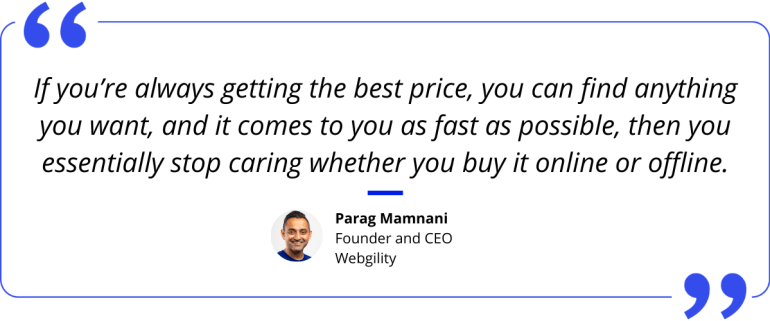
It used to be that technology was a limitation for the traditional brick-and-mortar retailer looking to sell online. Even if you successfully built an ecommerce site, you still needed to find customers. The Amazon marketplace changed all that. It leveled the playing field so sellers can easily list products online and get sales, but it also made it difficult for small businesses to stay competitive. Because the bar is so high, businesses have to cut their margins, leverage automation, and really extend their brand and service to stand out.
How did your experience at Amazon impact your approach to Webgility?
Parag Mamnani: I always enjoyed data and considered myself a bit of a data nerd, but Amazon transformed that into a data obsession. It’s become a part of Webgility’s culture to understand metrics and lead with data. Amazon is also the benchmark for being obsessed with the customer. Really listening to customers and doing what’s right for them has been an important part of the way I run Webgility.
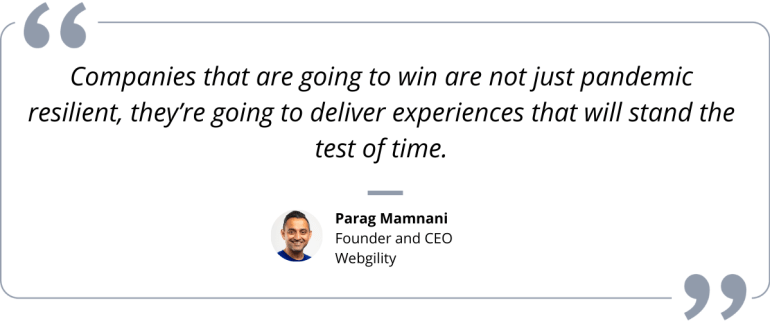
Where did you first see a need for a solution like Webgility?
Parag Mamnani: I started Webgility even before I joined Amazon. The idea came from my previous startup, Gate6. I saw that when we were building ecommerce software and storefronts, businesses would struggle to figure out their financials. They’d build an ecommerce store, but then they wouldn’t know how to get it connected to the rest of their business.
The more I researched the market and worked with customers, the more my business idea was validated. Almost every ecommerce client we’d support would have the same problem. They’d ask, “What do I do with my financials? How do I do my accounting? How do I get this data integrated correctly? How do I know what’s actually happening in my ecommerce channels?” The problem was obvious and unsolved.
Fast forward 14 years, and the problem has continued to evolve. We’ve been hard at work trying to automate everything, and I think we’re very close. The real challenge around financials and accounting is that it’s a moving target. The standards around accounting for ecommerce are constantly changing, and new ecommerce channels and strategies aren’t making it any easier.
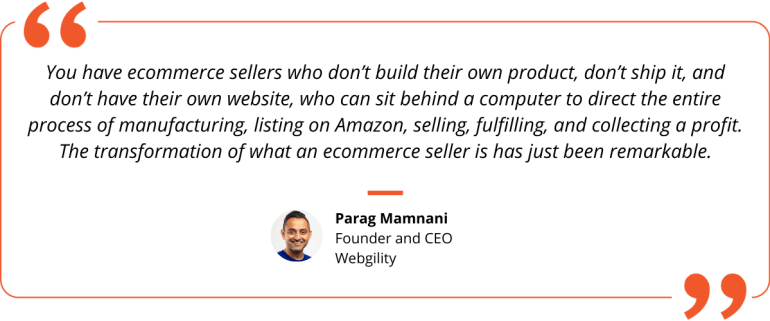
Why do you think omnichannel is the way of the future for Webgility?
Parag Mamnani: Webgility’s original focus was on accounting, but that’s just one small part of running an omnichannel retail business today. Retailers and brands face a variety of operational challenges that hamper their growth. Accounting and financial reconciliation is one of them. Shipping and fulfillment is another. Inventory and supply chain is yet another. When you think about the pain points of an omnichannel seller, they’re across the board.
Even 20 years ago, retail involved going to a store and buying something. Fast forward to today: you have ecommerce sellers who don’t build their own product, don’t ship it, and don’t have their own website, who can sit behind a computer to direct the entire process of manufacturing, listing on Amazon, selling, fulfilling, and collecting a profit. The transformation of what an ecommerce seller is has just been remarkable. And whether you’re an Amazon reseller, a brand, or an omnichannel retailer, you need tools, automation, and a really good grasp on your data to be successful.

Any advice for retailers navigating the near post-pandemic landscape?
Parag Mamnani: COVID-19 has completely transformed the retail landscape, but the industry was already on its way even prior to the pandemic. Online shopping accounts for nearly 20% of all retail—that’s $5 trillion spent on ecommerce this year. We were already on the path of buyers expecting next-day delivery, more selection, and geographic boundaries being broken. COVID simply accelerated the inevitable.
Small businesses have a really difficult challenge on their hands. Whether they realize it or not, they’re behind and they need to catch up. The pandemic shifted the industry five years into the future in one year. Whatever you had planned for your business in five years, you need to be there now. You have to learn quickly, embrace technology, and make your business future-ready. It’s a big mistake for any retailer to think that with reopening they can go back to how they were before the pandemic.
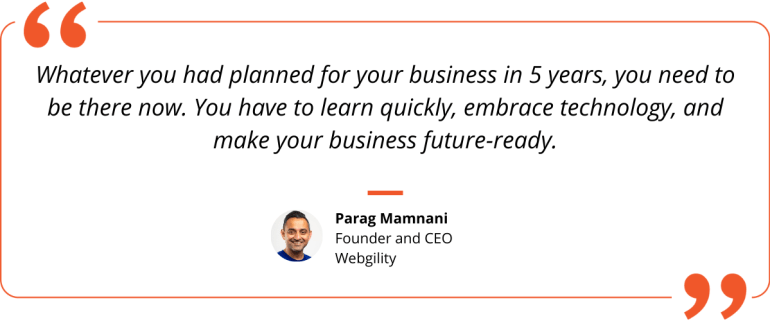
Look at how the big brands have shifted. Nike just saw their biggest quarter in the history of the company, and it was fueled primarily by ecommerce. They cut ties with Amazon and shifted to selling their products directly to consumers. I don’t expect small businesses to act like Nike. But I expect if they aspire to become a Nike—a big company, a big brand, ubiquitous—then they should take pointers from what these companies have done to keep up. They may not have the same budget, but they can find ways to create their own path for growth at whatever scale they are.
Companies that are going to win are not just pandemic resilient, they’re going to deliver experiences that will stand the test of time. Now is the time to be innovative and focus on building your brand. Every entrepreneur should go back to the question of what’s unique about them and how they can be creative in solving the problem.



 The Webgility Team
The Webgility Team